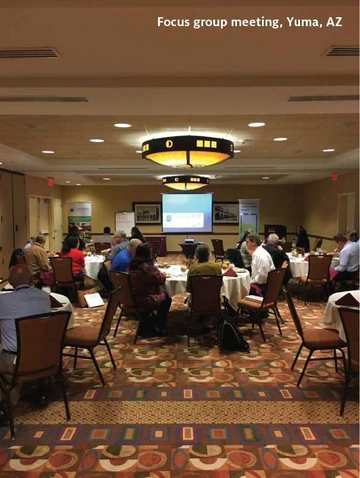
Two water quality research projects, funded through the Water Resources Research Center, reported their results in May. The WRRC receives funding from annual appropriations to the U.S. Geological Survey to support the national Water Resources Research Institutes program. Some of this funding is allocated each year to research projects proposed by faculty at Arizona’s three state universities. A wide range of projects has been funded over the years, emphasizing the mandated program goals of improving water supply reliability and quality, exploring new ideas to address water problems, and expanding understanding of water and water-related phenomena.
In the project year that ended this spring, projects led by University of Arizona researchers Channah Rock (Recycled water use for agriculture: on-farm demonstration and evaluation research) and Robert Arnold and David Quanrud (Sunlight-driven reactive oxygen species production for natural attenuation of wastewater trace organic compounds) were selected for support.
The Rock project concerned the use of recycled water for agricultural irrigation and its potential for bioaccumulation of emerging contaminants, antibiotics, and antibiotic resistant bacteria. Recent drought pressures in the West have forced some growers to cut water use by 25 percent, which has spurred a consideration of recycled wastewater for crop irrigation. Recycled water has the advantage of being a constant and reliable water source and its use on a volume basis is growing at an estimated 15 percent per year.
The long-term goal of this project was to assess industry perceptions of the risk to consumers from the use of recycled irrigation water in agriculture and to develop industry-based tools and guidelines. It asks the question whether the risk of exposure to organic contaminants found in recycled agricultural irrigation water represents a barrier to its use. Tools and guidelines are intended to facilitate the making of informed decisions by produce growers and related stakeholders about the utilization of recycled water.
Two focus groups were convened: a citizen panel of representatives with knowledge in a variety of fields and a panel of agricultural professionals (growers, producers, food safety managers, and irrigation districts). Both groups were asked to evaluate issues and concerns related to perceptions of recycled water and other nontraditional water sources. They were presented with information on costs and benefits related to public acceptance, health and safety concerns, and environmental considerations and were asked to consider these costs and benefits in their evaluations. Grower participation was encouraged through flyers, word of mouth, and efforts by University of Arizona Cooperative Extension to promote the program through newspaper, email, and flyers distributed at grower events. The results of the focus groups formed the foundation for the development of tools and guidelines.
Feedback from stakeholders indicated that on-line tools, web-based grower Apps, and short videos are often preferred methods of communication. A web-based interactive water information tool was developed covering topics such as nontraditional water sources, water availability, water quality, food safety, and Best Management Practices. In addition, a series of short instructional videos reviewing concepts of nontraditional water sources as well as risk assessment was developed with support from the Yuma Center of Excellence for Desert Agriculture.
Overall, the Arizona agricultural industry is concerned about consumer perceptions of recycled water and its use for agricultural irrigation. These perceptions necessarily affect how growers respond to the need for conservation and utilization of recycled water. Broad dissemination of reliable information on the risks is essential for wise decisions.
In their study, investigators Arnold and Quanrud noted, like Rock, that the need for water conservation in the American Southwest means that wastewater reuse is being considered, and cost-effective treatment that minimizes safety risks remains an important research goal.
For almost two decades, it has been known that treated wastewater contains low concentrations of many organics that enter sewage through human activity. Examples include a variety of pharmaceuticals and industrial chemicals. Many of these trace contaminants decrease in concentration over time and distance traveled in surface water. The mechanisms for contaminant loss or transformation are seldom known, however. One candidate is sunlight-driven reactions, either of direct photolysis, in which light energy causes chemical conversion, or indirect photolysis, in which light energizes a chemical intermediate or “sensitizer”. The sensitizer reacts with a contaminant or starts a chain reaction that results in degradation or elimination of a contaminant. An example of a sensitizer is singlet oxygen, an energized form of the normal oxygen molecule. The importance of singlet oxygen to indirect photolysis was fully acknowledged only recently.
Better understanding of this chemistry may allow us to use photolytic reactions to destroy residual organic compounds in municipal wastewater, minimizing both ecological and human exposures. The project research was designed first, to establish the mechanism of photolytic transformation of a common class of contaminants in treated wastewater and then, to simulate that mechanism mathematically for a simplified situation.
The experimental setup consisted of a light source and reactor. The target compound and sensitizer were dissolved in either treated wastewater obtained from Pima County or pure water. Experimental results indicated that light energy and molecular oxygen were necessary for photo-degradation of the target contaminant. When light was absent or when oxygen was stripped from solution, no reaction was observed. The reaction was also missing when treated wastewater was replaced by pure water. Results support a mechanism in which light activates a compound or compounds in wastewater (sensitizer), which convert molecular oxygen to singlet oxygen, which then reacts with the target. Since no reaction occurs without oxygen, it is clear that the active sensitizer in treated wastewater does not react directly with the target contaminant. In addition to these experimental results, the reaction mechanism was successfully simulated mathematically.
With additional work it will be possible to discover the nature of the sensitizer(s) in treated wastewater and to identify the range of wavelengths in simulated sunlight that are responsible for initiating photolytic reactions. With this knowledge, trace contaminants that survive conventional wastewater treatment may be better managed through engineered, photolytic treatment.

